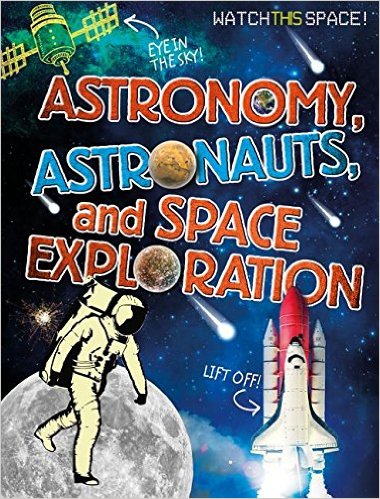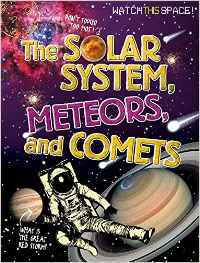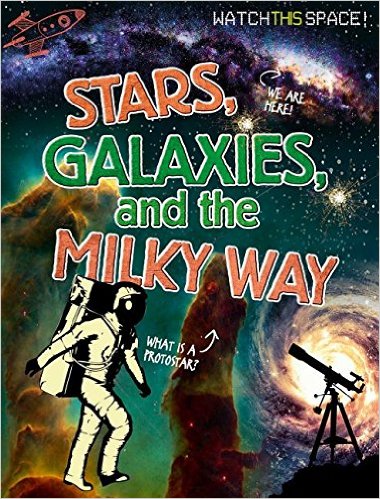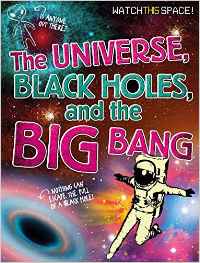| ________________
CM . . .
. Volume XXII Number 22. . . .February 12, 2016
excerpt:
There are two aspects readers will immediately notice about Crabtree’s “Watch This Space!” series. One is the presentation of complex scientific observations about astronomy and space exploration in three or fewer sentences. The other is the frequency of the use of numerals in presenting this information. In view of the first of these two features, the four books in this series should be looked upon as reference works rather than works of nonfiction to be read from cover to cover. There is simply too much information to make sense of, particularly for those being introduced to the concepts such as the Grade 3 and Grade 4 readers the publisher includes in the Grades 3-6+ interest level. The second feature suggests that an understanding of big numbers is necessary as phrases such as “over a million light years long,” “400 billion stars,” “a thousand billion years,” and “temperatures may sour as high as 100 billion C” are not uncommon. In Manitoba schools, it is not until Grade 5 that students are expected to represent and describe numbers to one million. In Grade 6, they extend this number pattern knowledge to numbers in the billions and trillions. It is at this point in their mathematical education that readers may begin to understand what it means for light to travel 299,792,458 meters in a second and 9,461,000,000,000 kilometers in a year – a light year. The light year is the unit astronomers use to measure distances, and it is frequently used in author Clive Gifford’s discussion of the contents of space beyond the Solar System. For example, in Stars, Galaxies, and the Milky Way, readers are told that “a super massive black hole”, called Sagittarius A, located in the center of the Milky Way, is about 27,000 light years from our solar system, and that it would take a light beam on one side of the Milky Way 100,000 years to travel to the other side; that’s 100,000 years x 9,461,000,000,000 km, while light from the Sun travels past Neptune in less than one day (pp. 28 & 29). There is no denial that much of the information Gifford includes is complex, but it’s also awe-inspiring. It’s difficult to identify single passages from each book to include as excerpts (see above) because so much is simply astonishing. You can’t help but wonder how scientists have come to understand the expanding universe, exoplanets, quasars, galactic nuclei, starquakes, supernova, neutron stars, stellar nebulae and so many other astronomical entities and events using only optical telescopes on land and in space and radio telescopes as dishes or interconnected groups of dishes in various locations called arrays. As equally interesting are the technological developments and remarkable planning that resulted in explorations of the Solar System. These include NASA’s Apollo missions to the moon, the building and maintenance of the International Space Station, the unmanned orbiter probes and lander probes that explore asteroids, comets, and the moon-like satellites of the planets, the rover probes that explore Mars, and the fly-by probes like Voyager 1 that was launched in 1977 and is the farthest spacecraft from Earth (over 19 x 1010 km) travelling in interstellar space. The title of each book alludes to its contents, but there is much more than the three big ideas identified. In The Universe, Black Holes, and the Big Bang, for example, readers encounter some terminology, such as Astronomical Unit, and, through the use of words and diagrams, learn the difference between group, cluster, and supercluster galaxies. There is also historical information (see the excerpt Galactic Breakthrough above) associated with ideas about the universe. These include how the universe began approximately 13.7 billion years ago (the Big Bang), its shape (finite or infinite), when protostars began to develop and galaxies formed, how the space between the galaxies is expanding, and theories explaining how, in the far distant future, the universe might end. Black holes are described on pages 16 through 19, and it is here that Gifford distinguishes between black holes that are the consequence of a supernova and the star’s core collapsing on itself and supermassive black holes at the center of galaxies that don’t start out as stars but have an origin that is, as yet, unknown. Gifford tells readers when the first black hole was discovered and what scientists look for and use to detect a black hole. They also learn about galaxies with two orbiting black holes, and a black hole that produces the lowest note in the universe. Pages 20 through 27 include information on an active galaxy that is 12 million light years from Earth and visible in our night sky, quasars, dark matter and dark energy and other strange and mystifying phenomena, and the on-going search for extraterrestrial life. The four books in the series have a similar design and layout. Each two-page spread has a heading identified in the table of contents. Within these two pages, information is presented using four or more fonts of differing sizes, stock photographic images, text boxes with a variety of shapes and colours, and an assortment of what appear to be hand-drawn doodles of stars, rockets, a spiral galaxy, telescopes, an astronaut’s helmet, the ringed planet Saturn, and the like. A glossary occurs on page 30, short lists of three supporting texts and three relevant websites are found on page 31, and the final page contains an index. The cover of each book, designed by Lisa Peacock, reflects the cluttered layout and design of the interior pages more than the content. The background of Stars, Galaxies, and the Milky Way is composed of photographic images of the Milky Way, a spiral galaxy, and the gas columns of Eagle Nebula where stars form. Superimposed on these images are a doodle of a rocket, a silhouette of a telescope, two Type II supernovas, two hand-written notes, and what looks like a pen and ink drawing of an astronaut in an Extravehicular Mobility Unit (EMU) suit. With the exception of “and the,” the title is all caps, in two colours, and in three lines that are at different angles with respect to the top and bottom of the book. For content that is inherently interesting, it’s not clear why the decision was made to represent it so unattractively. The series is highly recommended for public and school libraries and to parents of children with an interest in space and the scientific study of the universe who look at the night sky with awe and wonder. Highly Recommended. Barbara McMillan is a teacher educator and a professor of science education in the Faculty of Education, the University of Manitoba.
To comment
on this title or this review, send mail to cm@umanitoba.ca.
Copyright © the Manitoba Library Association. Reproduction for personal
use is permitted only if this copyright notice is maintained. Any
other reproduction is prohibited without permission.
Next Review |
Table of Contents for This Issue
- February 12, 2016. |



